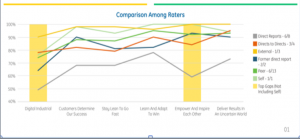9 types of difficult colleagues (and how to handle each one)
Nick Robinson explains simple, direct strategies to deal with the most common types of difficult colleagues.
When handling difficult people at work, it’s essential to first spot and understand their type. This allows you to actively deal with a tricky situation at work in a much more focused, supportive, and effective way.
Here are the nine types of difficult people you might encounter and some handy tips for what to do about it, whether you’re working alongside them, or just want to help that person not be so, well, difficult.
The scary specialist
This individual is an expert in their field and isn’t afraid to let you know it. They appreciate competence in others and set very high standards. You’ll need to be great at helping them produce good work, or they’ll become obstructive and critical.
You’ll need to become “scary” by protecting your boundaries and demanding they take responsibility for developing competence in their interpersonal and functional skills.
The dark strategist
This person treats others like chess pieces to deliver an ambitious grand plan. Their execution of details can be flawed and leave people feeling manipulated and undervalued, however positive their intention.
If you can speak their language (big-picture, strategic thinking) that’s enough to encourage a rounder approach, so they treat people as people and manage tasks as well as strategy.
The martyr
This highly principled person with a strong work ethic builds fiercely loyal teams. They can become judgmental, uncompromising, and disconnected from people they regard as less principled or self-sacrificing.
To reconnect you’ll need to visibly live up to your own principles. And don’t tolerate those criticisms or judgments. Instead, knock on their door and ask for a mutual compromise that makes sustainable progress possible.
The driving force
Resourceful, decisive, and can-do, they love a challenge and can’t stand a timid corporate agenda or anybody who isn’t also a can-doer. They tend to bite off more than they can chew and may try to keep it secret.
You may need to protect your boundaries around not taking on too much workload. Be direct and positive in this and they’ll usually respond well. For example, you might say, “I’m working too fast and it doesn’t feel sustainable. I need to slow down on task X so I can continue to contribute properly. I believe the way to do that is [offer a solution].”
The revolutionary
This self-starter readily embraces new ideas and far-reaching transformation. They often act without consensus or regard for the massive fallout they can cause.
Working successfully with a revolutionary is about finding your common ground. Even then you’ll need to avoid getting caught behind the lines of their guerrilla action. Instead, help to maintain links to possible allies, don’t get burnt out, and insist on good project management.
The empire builder
They are charismatic and visionary. They rely on followers to handle details and try to sweep up more control to avoid criticism or inconvenient complications.

Learn how to disagree with them using a “Yes, and . . .” approach, so that uncertainties and complexities are dealt with openly. For example, you might say: “Yes, of course, the plan of action you’ve committed us to could work. And there’s a possibly tricky issue we might have to deal with first. Then make sure you’re not doing their dirty work only to get tossed aside when no longer useful.
The worrier
This person is very detail-focused and helpful except when worrying causes them to drop the ball at the wrong time or become a dreadful micromanager.
Give them plenty of affirmation and mentoring to stop them from becoming difficult. Either work smart around them, avoiding or bouncing back their increasing demands for more detail, or give them a clear wake-up call that you won’t tolerate being micromanaged. For example, throw your papers on the desk and tell them, “If you know how everything needs to be done, why don’t you do it.” I have done this with a worrier boss who later became a good friend.
The rock
This highly responsible and loyal person keeps everything running. They will immovably refuse anything they consider risky, ill-thought-out, or low-priority, usually silently and without telling you.
Overcome this by ensuring they’re included in bigger-picture planning, so they understand the overall priorities. Counter their inflexibility and unresponsiveness by pattern-matching, framing your needs in terms of the risks of not addressing them.
The people pleaser
This is a warm, self-effacing person trusted by everyone. Their conflict- and change-avoidance can mean big risks stay unaddressed and significant opportunities are missed.
Ensure they haven’t agreed to challenging tasks with no intention of completion just to placate you. Support and encourage them to have tough conversations. And don’t tolerate poor behaviors or low standards from other team members that the People Pleaser might be overlooking.
The best way to deal with a difficult person at work is with the principle of “fierce kindness.” Kindness to understand and support them, so they develop new, more flexible ways of responding to pressures. Fierceness to first put right any organizational failings and then draw unmistakably clear lines around what is and isn’t acceptable behavior. Do this, and work becomes a place where everybody can be their best.
ABOUT THE AUTHOR
Fast Company – work-life
(3)







